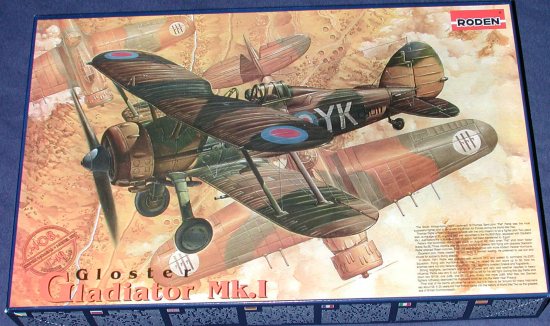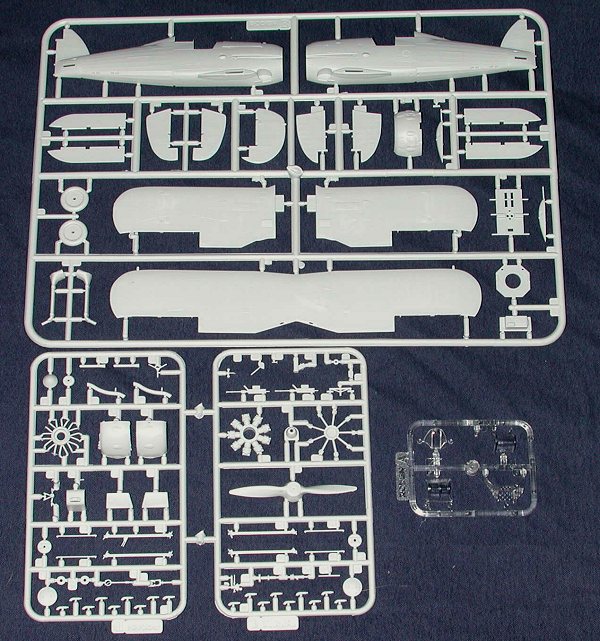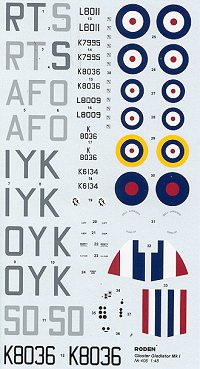
|
KIT: |
Roden 1/48 Gloster Gladiator I |
|
KIT # |
408 |
|
PRICE: |
$27.98 ($23.96 at Squadron) |
|
DECALS: |
five aircraft |
|
REVIEWER: |
|
|
NOTES: |
It's about time!!! |

|
HISTORY |
The Gloster Gladiator was the RAF's last biplane fighter. The prototype (K5200) first flew in September 1934 designated S.S. 37, and although produced a private venture, conformed to Spec. F.7/30 (to which also the original gull-winged Spitfire had been designed). In July 1935 the Gladiator was ordered for the RAF to Spec. 14/35, the initial contracts being for 23 (commencing with K6129). A further 186 (commencing with K7892) were ordered in September 1935 and production continued until 1940.
The Gladiator was produced in three major version; Mk.I, Mk.II and the Sea Gladiator (the difference of the Sea Gladiator being installation of catapult points, a deck-arrester hook and a collapsible dinghy in a fairing beneath the fuselage between the undercarriage legs). Largely replaced in Fighter Command by the outbreak of war, they went to serve with 607 and 615 Squadrons of the AASF (few records survived the German invasion of France but 607 Sq. is thought to have destroyed around 70 enemy aircraft, mostly however with Hurricanes) and equipped one squadron in the Battle of Britain (247 Squadron at Roborough) charged primarily with the local defense of Devonport Dockyards, Plymouth. Most famous is the Gladiator for its exploits overseas, including operations in Norway, Malta and the Western Desert. The Gladiator was also one of Britain's biggest export successes before the war, seeing service with Lithuania, Sweden, Norway, Latvia, Finland, Egypt, Portugal, and many other countries.
|
THE KIT |

Over the years that Roden has been around, their models have steadily improved. The more recent WWI kits have been real jewels and have been highly commended by those who have built them. It was with much anticipation that we awaited this Gladiator kit. So what is the story on it? Well, when on considers that the previous kit, by Pyro, Lindberg and several others, wasn't that bad, we knew that Roden had to pull out all the stops. From the looks of what is in this box, they have.
It is molded in their typical light grey plastic and comes on one large, two small and one clear sprue. There are sprues dedicated to the Mk.I as there will be for the Mk.II and the Sea Gladiator that is to come. The clear sprue has a three piece canopy and the instrument panel. It is expected for the modeler to affix decals to the back of this panel and paint the front as on the Accurate Miniatures Mustang kits.
The plastic bits show signs of some flash on a few of the bits, most notably the cowling pieces of the D sprue. The others are quite minimal. There are also a few light sink marks on the fuselage opposite the internal detailing and where there are small ejector stubs. The only other place I noted this phenomenon was on the very thick sections of the landing gear struts where they attach to the fuselage. All should be easy to fill.
 As you might imagine, the level of
detail and so the number of parts are both high. The engine has 18 separate
exhaust stubs and comprises 26 parts. The cowling is in three sections and even
the cockpit itself is comprised of 14 parts. Both pilot entry doors are separate
as are all the control surfaces. With the exception of the fin, all the flight
surfaces are a single piece. The fabric effect is quite good and subdued without
the 'hills and valleys' of some fabric covered aircraft kits.
As you might imagine, the level of
detail and so the number of parts are both high. The engine has 18 separate
exhaust stubs and comprises 26 parts. The cowling is in three sections and even
the cockpit itself is comprised of 14 parts. Both pilot entry doors are separate
as are all the control surfaces. With the exception of the fin, all the flight
surfaces are a single piece. The fabric effect is quite good and subdued without
the 'hills and valleys' of some fabric covered aircraft kits.
Instructions are excellent and offer color and paint information for Humbrol, Testors, Gunze and Lifecolor paint lines. There are markings for five aircraft, all in the green/brown upper disruptive color except for one. Though Roden doesn't point this out, from what I've been able to read, there are actually four upper surface colors on Gladiators. The lower ones are lighter versions of the upper colors. I suggest some reading for more info on this.
Decals superbly printed and I'm willing to bet that they work well. The first plane is an all aluminum doped version from 33 Sq in Palestine just before the war. Next is an 80 Sq aircraft with a yellow circle on the fuselage insignia and none under the wings. The lower port underside of the plane is painted black with white on the rest of the underside. That sounds suspiciously wrong and I'm thinking it should be aluminum doper or sky. Similarly painted is a second 80 Sq aircraft. The other two have the port side of the upper wing also painted black. The 112 sq plane from the Sudan has no under wing roundels, while the 607 Sq one from the UK does. As I said, I'd suggest some supplemental reading.
|
CONCLUSIONS |
Overall this is a superb looking kit. I can't imagine anyone finding anything really wrong with it as it seems that Roden has done its homework on this one. I can easily see this selling very well, especially in the UK!
|
REFERENCE |
You can find this kit and many others at

If you would like your product reviewed fairly and quickly by a site that has well over 175,000 visitors a month, please contact me or see other details in the Note to Contributors.